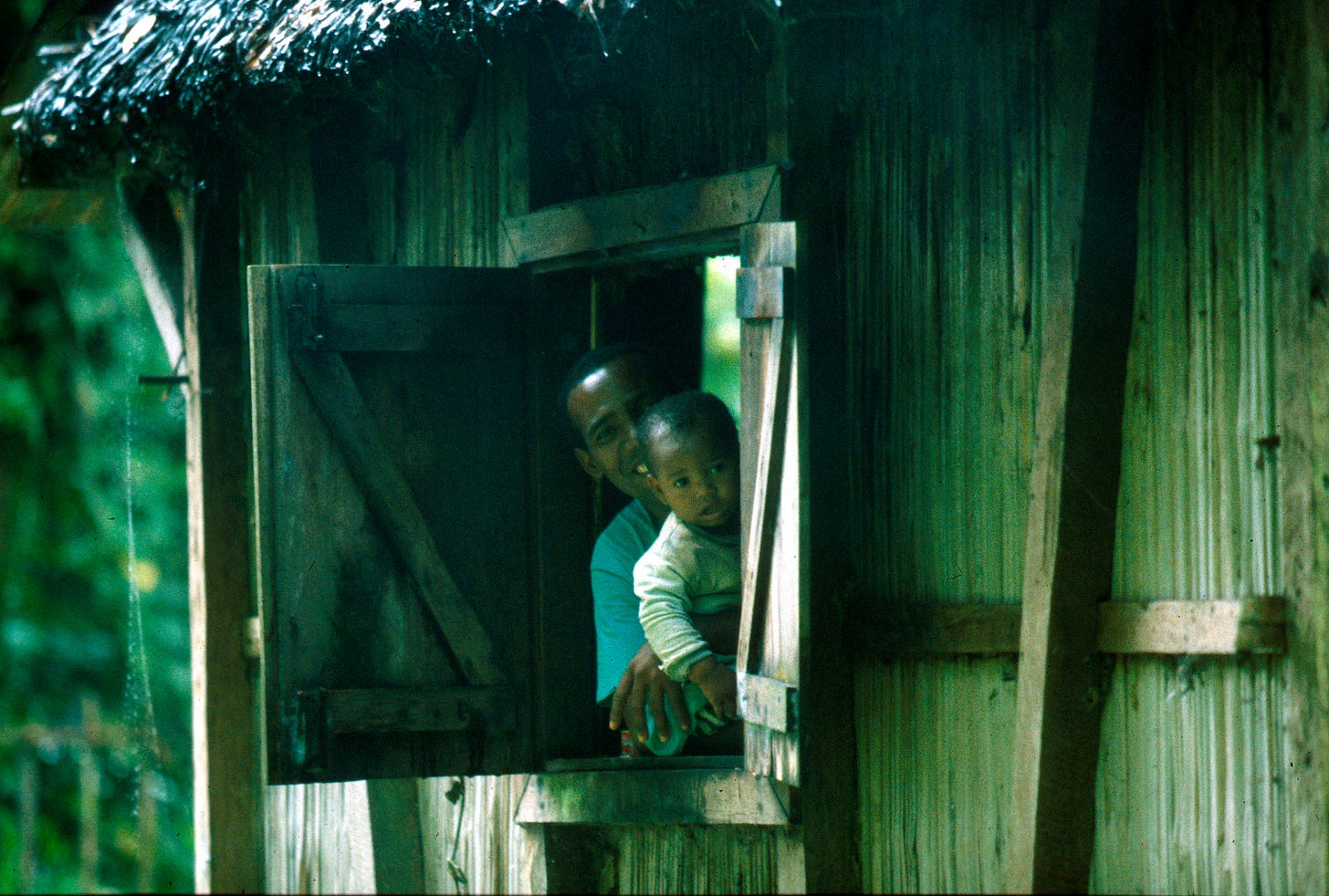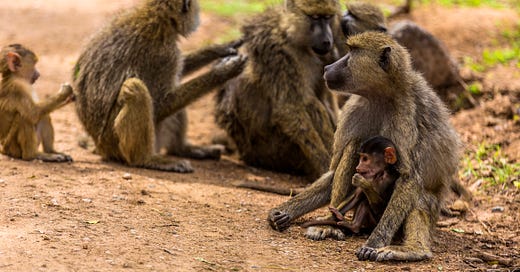For the vast majority of time that humans have existed, we have found meaning in basic Darwinian goals: survival and reproduction. People have been driven to find food and shelter, mates and friends, and to protect these things from theft or destruction.
We still care about these things, of course, but beginning with the invention of agriculture, accelerating with the rise of city-states and empires, even more so come the Industrial Revolution, and now with the Information Revolution, some of these concerns have become far more remote from daily life. While modern humans still must eat and sleep and be protected from the elements, mostly we have outsourced the details: Figuring out what plants and animals to eat, how to hunt or harvest them, and how to get them to us. Many of us even outsource the preparation of our food. And few of us build our own homes; if we do, we likely use lumber and hardware that was milled and machined far away, by people who will remain anonymous to us forever—unrecognizable even if we were to pass them on the street. And with regard to protection, most of us are lucky to live far away from war zones, to live in societies that are functional enough to have quieted the most anarchic of our impulses, at least usually.
But even as many ancient concerns feel ever more remote, friendship, for now and for ever, remains central to what it means to be human. For far longer than we have been human, we have been social and long-lived. And for far longer than we have been human, we have had friends.
Friendship looks different under different circumstances, and specifically, varies by sex in most species. Friendship is more than just an alliance; it is an alliance that doesn’t require constant reassessment. Friends have long-term emotional attachments, and show an ability to behave selflessly towards one another in a manner not observed between mere allies. In her work on baboons, Barbara Smuts found that spatial proximity and frequency of grooming were useful criteria in determining who was friends with whom. In other monkeys, the duration, rather than frequency, of affiliative acts is a better indication of friendship (e.g. sooty mangabeys, blue monkeys). Regardless of how we tell, though, monkeys of many species, of both sexes, have friends.
Given that friendship is so much older than humanity, we were, as early humans, very interested in our social group, our affiliations and our standing, and how we might improve and retain these things. This fact has not changed substantively in the last 10,000 years, or even the last 100, although first movies, then television, and now internet and social media, have transformed who people view as friends.
True friendship requires connection between many domains—not just the obvious connection between individuals. Yes, to become your friend, I must reach across a gap that seems impossibly large, to touch you, a wholly different human being who is living a life I can only imagine, and will never fully know. But I must also reach within myself and connect my inner and outer worlds, those parts of me that drive my behavior, with those parts that live on the surface and are easily seen by all.
In Howard’s End, E. M. Forster’s novel of pre-WWI England, we are enjoined to “Only connect.” Forster was, it seems, imploring us to find multiple kinds of connection—both that between individuals, and that within the disparate parts of a single human being. And he seemed to be advising us that it is both critical, and simple. Only connect.
Surely it is more easily said than done, though, as many of those feeling social isolation in the WEIRD 21st century can attest. Liking a social media post—be it because you share the adoration of a cute animal, or share anger at someone’s politics or ideas—does not a connection make. Social media commodifies connection—this connection that it brings is both easier than the ancestral version, and inferior to it. But for a fleeting moment, hitting the like button can make it feel like that gap between humans, across which it is so difficult to reach, has been bridged.
Nearly everywhere remote that I have traveled and lived, I have encountered a tension among the locals, a tension between valuing the lives and connections that they have, and valuing the prospect of accumulation of goods. In the 1990s I had a friend, Solo, who was a vanilla farmer living in a difficult to access part of a remote peninsula in Madagascar. He had never been anywhere else. We shared scant language, and little in our lives up until we met had been similar. But for a few weeks, we ate our meals together, and shared observations of the forest in which we found ourselves. His entire life was there—at the field site that he managed, which consisted of just three tent platforms and the little thatched-roof cabin where he stayed, and at a village several kilometers down the coast, which he traveled to by foot or by pirogue, to be with his family, and to hear the news of the other villagers. His youngest child was just an infant when I knew Solo, and once he brought his baby daughter with him to the field site, wide-eyed and open to the world as her father showed it to her.

For a very short time, my entire life was at that field site too. But I had taken several airplanes, starting halfway around the world, to do research on frogs I had only ever read about before. While there, I was just as dependent on the tides and the weather as he was. But I would not always be there. Before I left the first time—promising to return the following year, which I did—he asked me if I might bring him a rain jacket, like the one I had. He saw how much I had. And he thought that having a bit more himself might improve his life. I did bring him a rain jacket when I returned the next year. And he was both grateful, and a little hesitant.
For people without material goods, a good pair of shoes would surely make life easier, better. As would a roof that doesn’t leak. Electricity with which to power a lamp might be nice, since having light after sundown expands life’s repertoire. After that, perhaps a television, or a computer. Yet it is telling that many people without these things can see that there is a trade-off in having them. My friend Solo had no access to electricity or the things that require it, but he could fix his own leaky roof, and he was now in possession of a rain jacket as well. The rain jacket, though, it signaled to his fellow villagers that he was no longer entirely of the forest and the village, that he had a way to reach outside of it and hold on to something of the modern world, a convenience. It set him apart.
Consider Milpa Alta, the poorest borough of Mexico City. Every year in Milpa Alta, more than 700 religious fiestas are held—no somber affairs these, they are rich with food imbued with love and tradition, and joyful, raucous music. Everyone belongs to some extended family, and those families make sure that their people are fed and supported. There is value placed in the sobremesa—that time after a meal when the entire family stays at the table and talks. Juan Carlos Loza Jurado, an academic who grew up in Milpa Alta, says of its people in an excellent 2014 National Geographic article: “The environment, the kind of social relations they have, these things make their lives better. People say frequently, we are better off here.”
Some people, when asked to describe how they find meaning in their own lives, may say that they seek happiness. But happiness itself is not good. Happiness is also not bad. Happiness is an adaptation which, in times past, motivated us to seek that which was good for us. Our happiness-seeking circuitry, long evolved in situations where sugar, comfort, abundance, and safe thrills were rare, is now on overdrive, helping us find that which markets have made ubiquitous. So we need to reschool our happiness-seeking circuitry, train it to find and appreciate legitimately rare or valuable things. Sugar, comfort, abundance, and safe thrills are no longer legitimately rare or valuable. Love and relationship, and the time and space to exist in ways not dictated by external forces—these are increasingly rare, and have always been valuable.
Are the denizens of Milpa Alta, resource-poor but rich in fiestas and food made with love and long lingering conversations at the table, less happy or content than those of us in resource-rich communities? I think the answer is probably no, so long as they are not living in desperation, and haven’t yet had markets capture their ambitions. Instead, they are living in a world that more closely resembles ancestral conditions, and they are, I suspect, happier and very often healthier than their “wealthy” counterparts. Should we seek to reduce the resources available to all in order to spread these benefits more broadly? I think not. Rather, we should look to these communities to help us understand our modern world more clearly, and aid us in seeking a better way for all.
What can we learn from this and other examples of forced or chosen simplicity driving deep human connection? What can we learn about ourselves and our societies? Where are we headed? And where might we prefer to go?
Subscribe for free to receive a new post in your inbox every Tuesday; paying subscribers receive audio recordings of these Tuesday posts as well.






This is wonderful. These days after quitting all social media platforms except Twitter, I realize that it is hard for me to reach out to people because they are sucked into the abyss of instant gratification. I am trying to rescue them one by one. I will share this with them and hope they wake up!
I wait eagerly for this weekly balm of support. Again, sharing far and wide. Thank you Heather.